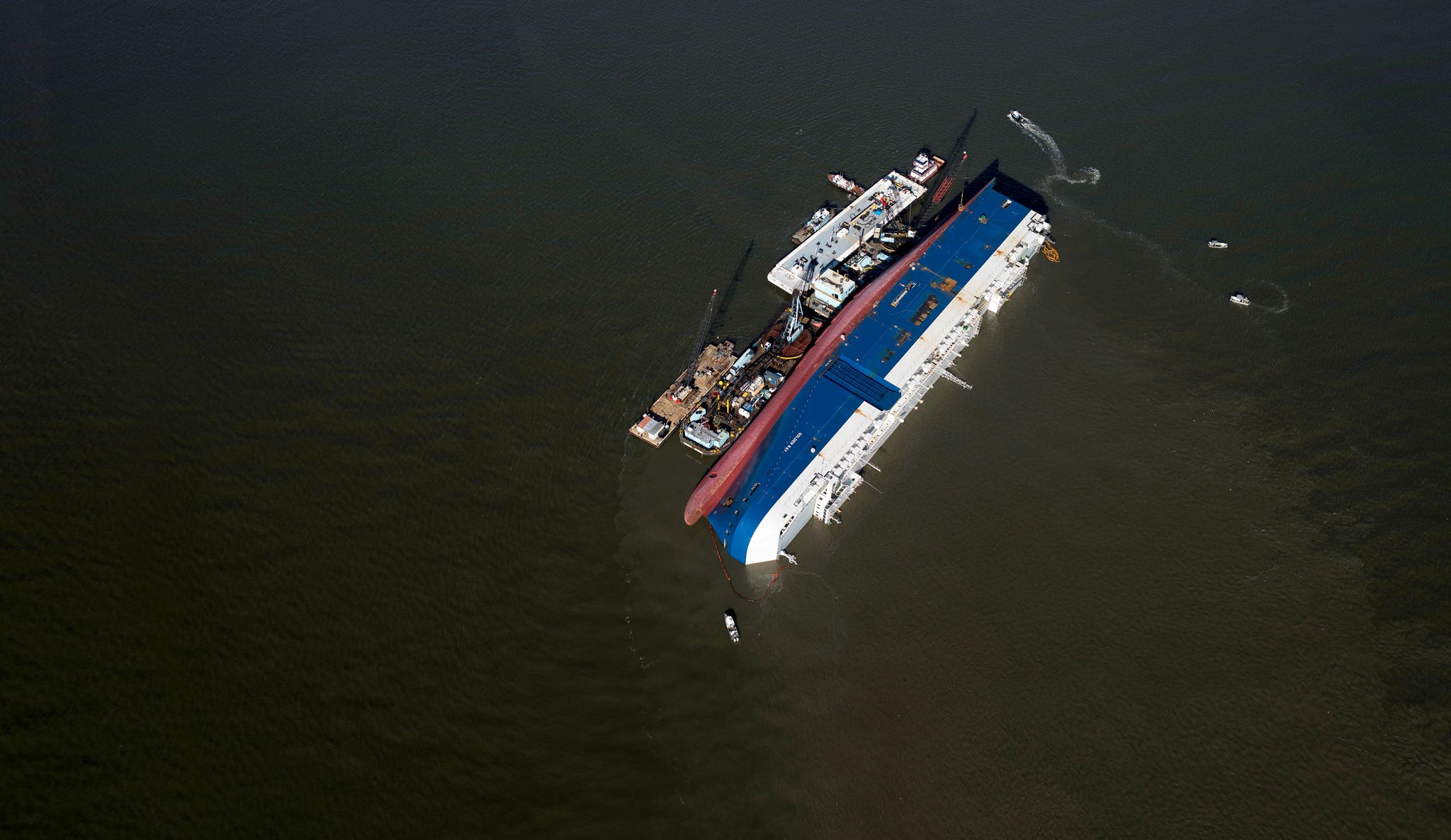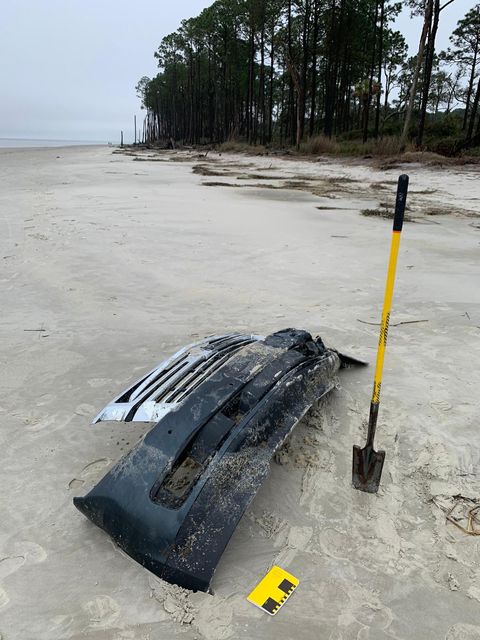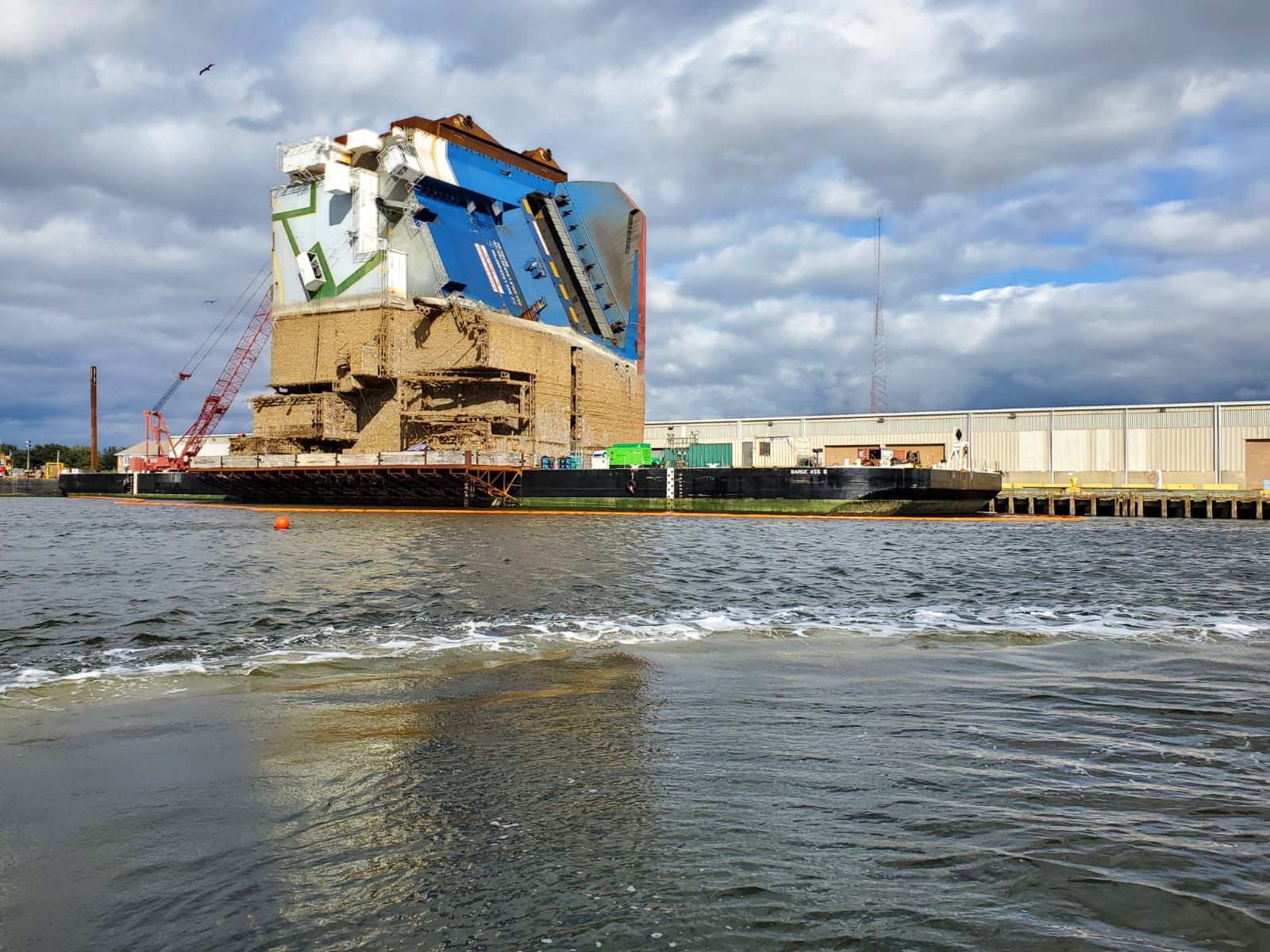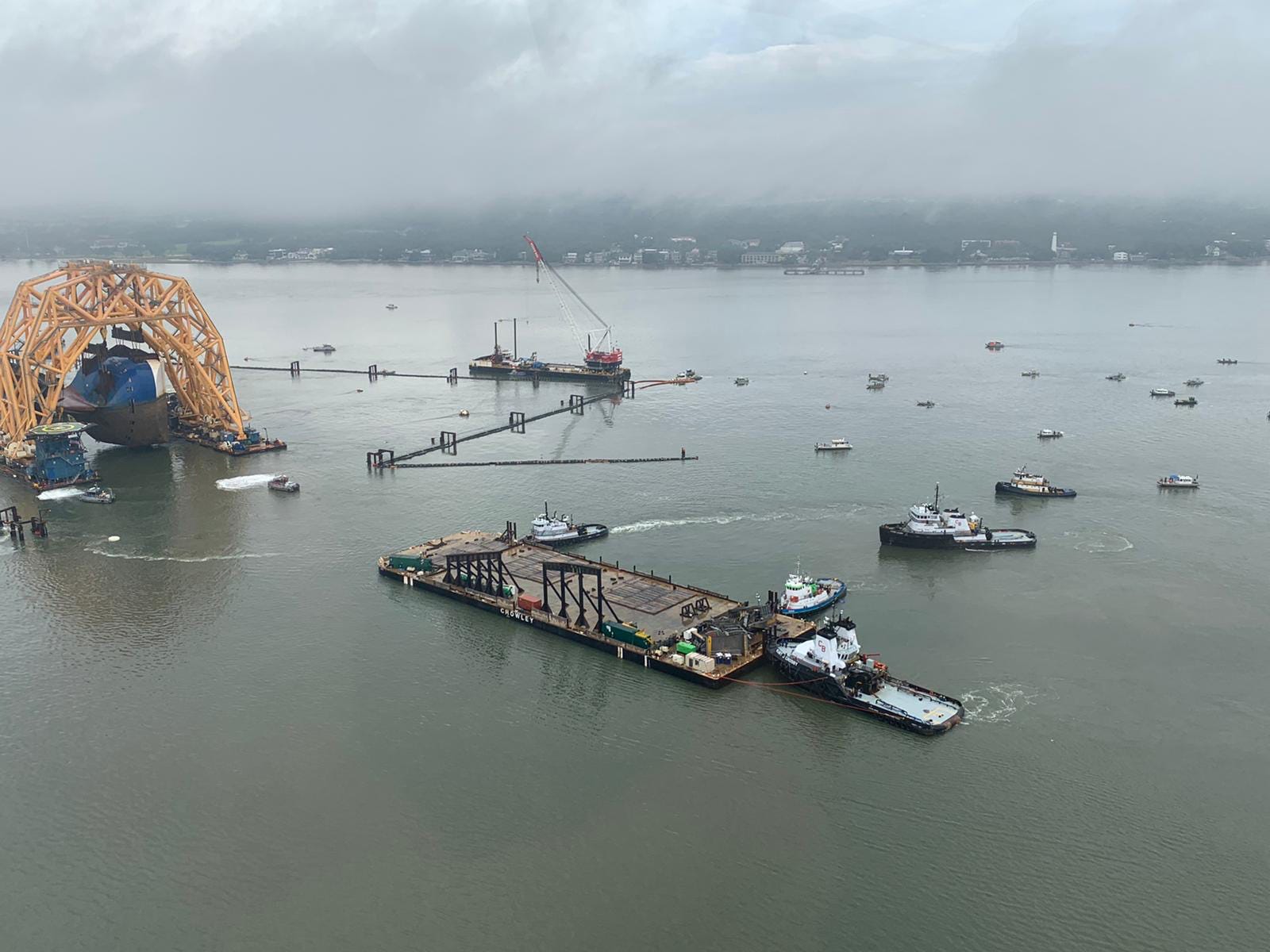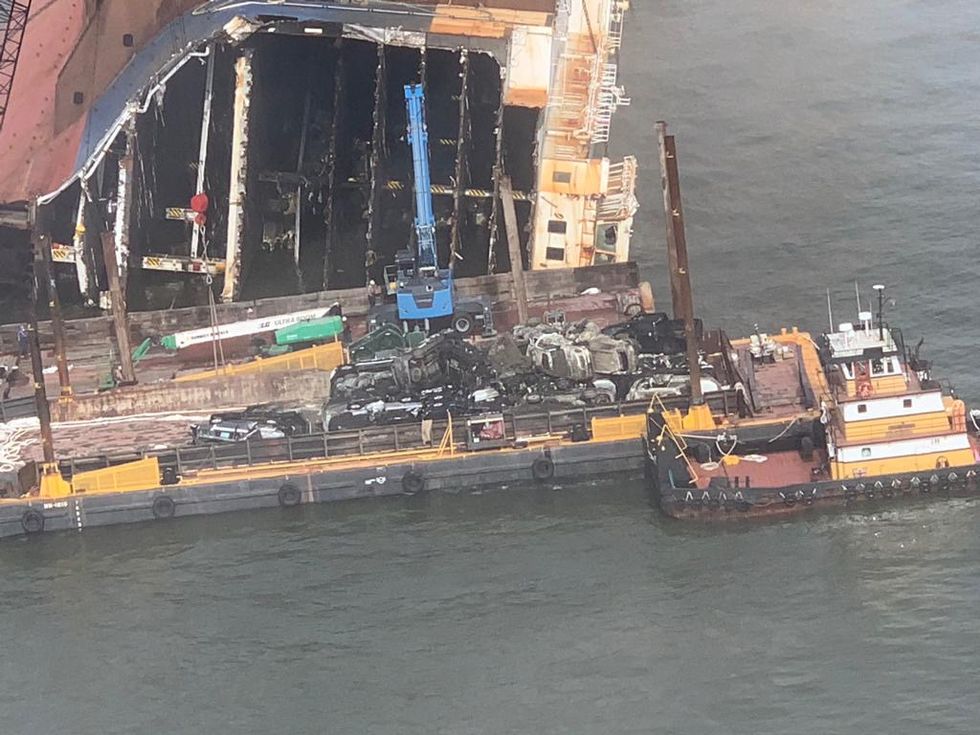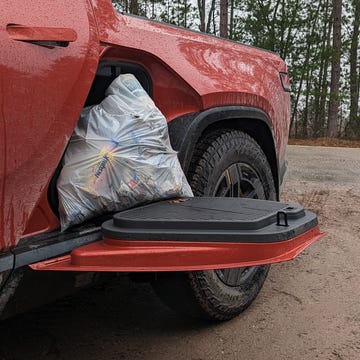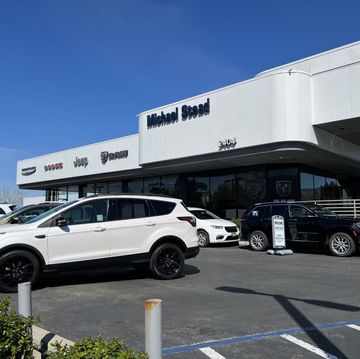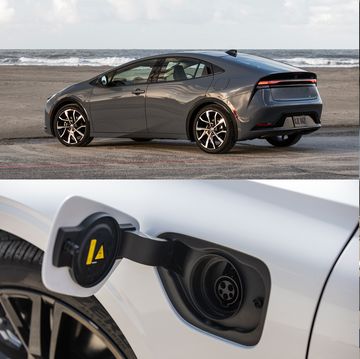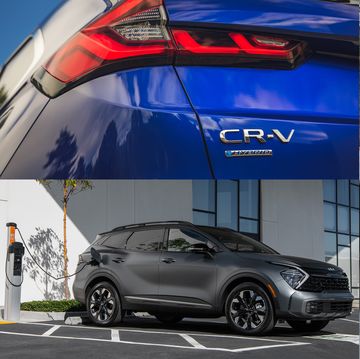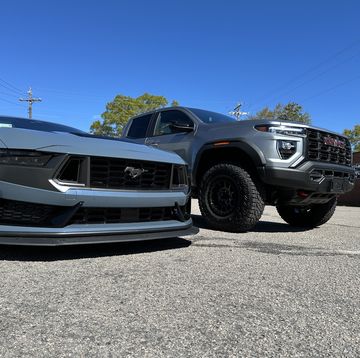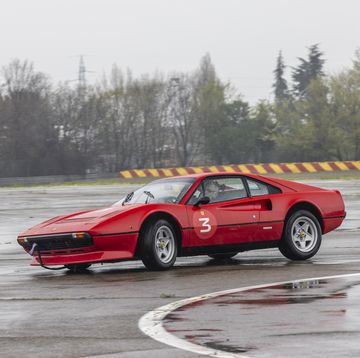From the April 2021 issue of Car and Driver.
The busy season on Saint Simons Island, Georgia, typically runs from Memorial Day to Labor Day. But 2020's tourist boom lasted well into November. A short detour off I-95, about halfway between Savannah and Jacksonville, St. Simons Island is known for golf and saltwater-based leisure pursuits. On one clear and breezy late-fall afternoon, people seeking a reprieve from their couches cruised the palm-tree-lined high street on foot or bikes; others sat on benches licking soft serve while staring at the fishing trawlers and cargo ships in the distance. The lower the sun dipped on the horizon, the more people drifted to the pier in pursuit of the perfect sunset snap. And amid all the smiles and poses, no one seemed to mind the giant shipwreck lurking in the background. If anything, they huddled closer together to keep the beached metal whale in frame.
Before it capsized, the MV Golden Ray shuttled cars through the auto industry's global supply chain for two years, leading a nondescript existence in the world of modern shipping operations. More than two football fields long and 17 stories tall, this roll-on/roll-off vehicle transporter makes your double-decker pontoon boat look like a bath toy. With its massive 17,335-hp 5522-liter two-stroke diesel inline-seven turning at a relatively lazy (for this magazine, anyway) 77 rpm, the Hyundai Glovis–owned ship plied the seas at a max speed of 20 knots (23 mph).
In September 2019, the Golden Ray departed the Port of Brunswick, Georgia, with a haul of about 4200 vehicles and soon developed a catastrophic list. The floating parking garage, with space for up to 7742 vehicles, tipped onto its side and beached itself just off the St. Simons Island shoreline. Nineteen months later, the Golden Ray's journey is finally nearing its end. This is the story, reconstructed from interviews and a multiagency investigative hearing conducted last September, of how a laden ship weighing approximately 38,600 tons lost its balance, became a gapers'-block tourist attraction on the Georgia coast, and launched a salvage effort that makes crushing cars look like child's play.
Even with Hurricane Dorian bearing down on Florida, the Golden Ray's final voyage was poised to be like any other assignment for the 23 Korean and Filipino seafarers serving in the ship's complement. The monthslong itinerary had the ship sailing from the Gulf of Mexico, up the Eastern Seaboard, and on to the Middle East. To avoid the storm, the Golden Ray treaded water after leaving Freeport, Texas, to slow its arrival to Brunswick, the nation's sixth-busiest auto port and an essential distribution outlet for the Hyundai factory in Montgomery, Alabama, and the Kia plant in West Point, Georgia.
On September 7, 2019, the Golden Ray eased into the harbor, where stevedores offloaded 285 Hyundai Accents and Kia Fortes from two decks and loaded 339 brand-new Kia Tellurides onto three. Harbor pilot Jonathan Tennant then joined the crew to navigate the boat out of the narrow shipping channel. Around 12:45 a.m. the next day, the Golden Ray raised its 275-ton stern ramp, and captain Gi Hak Lee declared it "ready for sea" and the voyage to Baltimore. Flanked by the Dorothy Moran tugboat, the Golden Ray made for the Atlantic with Tennant giving commands to the quartermaster at its helm. "Our job is very much about feel," he says. "You become in sync with the vessel." It was a still, 72-degree morning—"cupcake conditions," Tennant says. He remembers looking out at the moon, the lighthouse on St. Simons Island, and the lights on the Emerald Ace, an inbound car carrier. Once he felt in control of the vessel, he dismissed his tug so it could assist the Ace and pressed on, eventually ordering 10 degrees of starboard rudder to make the fourth turn of the voyage out to sea. But 10 degrees wasn't enough, so Tennant called for the next logical thing: 20 degrees starboard. That's when the ship began to lose it.
It was normal for the Golden Ray to lean while making the turn, but this "felt like she was going to spin out of control," says Tennant. Trying to slow the swing, he immediately called for midships (0 degrees), then 20 degrees port, then hard to port. When the ship didn't respond, he turned to Lee and asked, "What is happening?" Lee's reply—"Whoa!"—prompted Tennant to ease off a bit, to 20 degrees port. Suddenly, the ship's stern slid out "like someone kicking a stool out from under you," Tennant recalls. "The lights were gone. All I saw was water." Nevertheless, he kept driving, calling for full lock again, still hoping to right the ship. But unbeknownst to him, the rudder and propeller were already out of the water. Nothing could stop the Golden Ray from plowing into the sound.
The crash threw Tennant against the wheelhouse windshield, and he held fast to a gyrocompass to keep from sliding away. Water rushed into the vessel through an open door in the hull. Inside the upended engine room, engineers similarly clung to life in the dark as the seven-cylinder lost power and fires broke out across the disabled ship. With the stern stuck out in deep water, a flotilla of tugs and taxis responding to Tennant's distress calls converged on the capsized carrier to shove it onto a sandbar. The Golden Ray risked being dragged to the bottom of the channel, which could have choked off the busy shipping lane and drowned everyone aboard. Tennant is an Eagle Scout who still lives by the preparedness mindset at age 46. As he dangled 50 feet in the air, he thought about the rappelling gear in his work-issued F-250 Super Duty that was parked a half-mile away near the pier.
U.S. Coast Guard teams arrived by air and sea to contain the ship's fires and help Tennant, Lee, and 18 others escape. (True to maritime tradition, the captain refused to abandon ship before all members of his crew were safe, but Tennant convinced Lee he'd have a better chance of saving his men by leaving the vessel. That way, he could share his knowledge of the Golden Ray's access points with the Coast Guard.) Trapped in the bowels of the ship, four engineers stripped down to their underwear and climbed into the floodwaters seeking relief from air temperatures that hit an estimated 150 degrees. They banged on the hull to make their presence known. Nearly 36 hours after the accident, they were rescued through a hole cut in the hull. Tennant shudders to think what the outcome might've been had the ship rolled over at sea. "I don't believe there would've been any witness to it happening," he says. "And the ability to call for help would not have been there. I truly think that I essentially witnessed a miracle."
The 4200 vehicles onboard the Golden Ray were not so lucky. The loading-plan diagram shows that most of them were Ram pickups, GM crossovers, and Mercedes SUVs bound for the Middle East. Officially, the cause of the accident has yet to be determined. But the aforementioned hearing conducted last year by the Coast Guard, the National Transportation Safety Board, and like agencies from South Korea and the Marshall Islands (the Golden Ray sailed under the latter's flag) theorized that the ship had been loaded incorrectly.
U.S. Coast Guard Document Library
A Coast Guard forensic analysis zeroed in on the 411 tons of additional weight that the Golden Ray took on in Brunswick when it swapped those subcompact cars for SUVs. The ship had also discharged 1645 tons of ballast water en route from Freeport, and combined with an underloaded deck 5, the addition of the Tellurides raised the ship's center of gravity to a dangerous height.
Jeffrey Falzarano, a professor of ocean engineering at Texas A&M, likened the idea of righting a listing car carrier to "trying to balance a pencil on its tip." The hull door should have been closed at that point, and the fact that it was open "simply exacerbated the capsize," testified Lieutenant Ian Oviatt, who led the Coast Guard study. The full conclusion of the investigation likely won't be reached until fall at the earliest. Hyunjin Park, the officer responsible for vouching for the Golden Ray's stability, declined an invitation to testify at the hearing.
As for the monumental task of scrapping the shipwreck, well, it's taking some time. Initially, traffic through the channel slowed for about a month as response teams laid an oil-containment boom around the hull. Next, crews began the lengthy process of siphoning 320,000 gallons of fuel and water from 26 tanks in the Golden Ray. Meanwhile, some 6000 tons of one- to three-inch-thick rocks were dumped around the hull to slow erosion from the sea and forthcoming work vessels.
The 50-ton rudder and 100-ton propeller were torched off the carrier first and discarded in an artificial reef alongside M-60 battle tanks about 20 miles southeast of St. Simons Island. Then a salvage crew welded 16 steel girders, each weighing between 35 and 80 tons, to the Golden Ray's starboard side to serve as connection points between the eight ship sections and the 255-foot-tall twin-gantry catamaran that would lift them. Typically deployed to recover offshore oil rigs, the dual-barge VB 10,000 crane can lift up to 7500 tons at a time and adjust its lifting blocks to account for the shifting weights of the mangled vehicles in each rusted-out slice.
To make the seven cuts, the salvage team threaded a 400-foot string of 80-pound steel rings under the hull and attached it to the VB's lifting pulleys, which worked the chain back and forth to saw through the ship. The cutting began on November 6, 2020—425 days after the ship capsized—and came to a halt just a day later when the line broke. That was one of several setbacks, along with weather- and COVID-related delays, that pushed the recovery effort months beyond the initial estimate. After much sound and fury, on November 28, the first excised section began its barge ride to a Louisiana recycling yard. If work continues apace, the wreckage could be gone by this year's busy season.
Watch Salvage Videos on YouTube
Currently, some 400 people and 70 vessels are engaged in the cleanup effort. Their work doesn't come cheap. In a May 2020 disclosure, North P&I Club, the Golden Ray's U.K.-based insurer, expected the accident to run up more than $400 million in claims, a potential record for the 161-year-old company. Much of that cost comes from measures being taken to protect the environmentally sensitive Golden Isles coastline. (Rod Sullivan, a maritime attorney in Jacksonville, reckons capsizing in the English Channel would've cost a quarter as much.)
For all the financial carnage of the Golden Ray disaster, it provided a small windfall for some locals. Business owners on St. Simons Island initially feared the wreckage would discourage tourism. But the ship quickly became an attraction to rival the area's iconic lighthouse and Fort Frederica National Monument. Gawkers have flocked to St. Simons Island to snap selfies with the wreckage from the pier, down Golden Ray IPAs, and buy $15 T-shirts that say "Ship Happens." Tennant takes it all in stride. "Once those men survived, that was a game changer for me," says the pilot. "Now when I see that ship, she's nothing more than a wreck. When I see those T-shirts, I just chuckle and say, 'Yes, ship does happen.' "
UPDATE 3/19/21: Another section of the Golden Ray was hauled away earlier this week. Hundreds gathered to watch it go. The salvage operation continues and about 366 feet of the ship remain.

Andrew Lawrence is a freelance writer, and has written for Sports Illustrated, The Guardian, The Atlantic, The Athletic, The Dallas Morning News, the Associated Press, Fortune, Southern Living, Austin Monthly, Complex, Cookie, BET.com, ESPN.com and The Classical. He is based in Beaufort, South Carolina.
